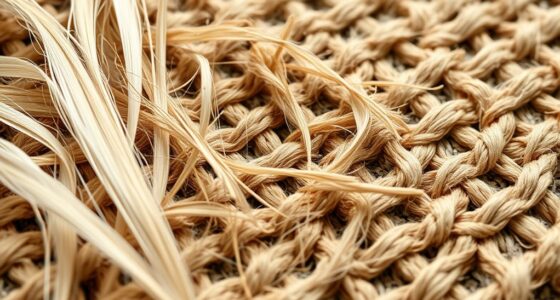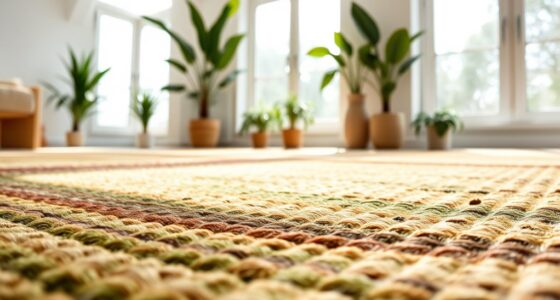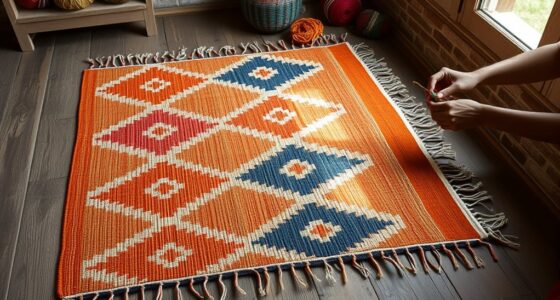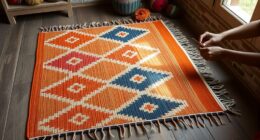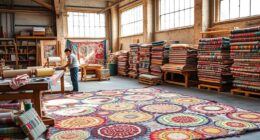Many brands are leading the way in creating carbon-neutral rugs by prioritizing sustainable sourcing, such as organic fibers and recycled materials. They use eco-friendly dyes, renewable energy, and waste-reduction practices to lower their environmental impact. Transparency is key, with companies openly sharing their efforts and sourcing stories. By choosing from these responsible brands, you support ecological health and sustainable manufacturing. Keep exploring to discover more inspiring companies making a positive difference.
Key Takeaways
- Many leading rug brands utilize renewable energy and waste reduction to achieve carbon neutrality in their manufacturing processes.
- These companies prioritize sustainable sourcing of fibers like recycled textiles, organic wool, and eco-friendly materials.
- They often offset remaining emissions through verified programs such as tree planting or renewable energy investments.
- Transparent reporting on sustainability efforts helps consumers identify brands committed to reducing ecological impact.
- Industry leaders promote eco-friendly dyes, responsible practices, and overall environmental responsibility in rug production.

As consumers become more environmentally conscious, many rug companies are taking steps to reduce their carbon footprint by pursuing carbon-neutral practices. One of the key ways they do this is through sustainable sourcing. Instead of relying on materials that harm the environment or deplete natural resources, these brands prioritize renewable, ethically harvested fibers like organic wool, hemp, or recycled textiles. By sourcing materials responsibly, they minimize environmental impact and guarantee that their rugs support eco-friendly practices from the ground up. This commitment to sustainability extends beyond just the raw materials; it influences every stage of production, from farm to factory.
Many rug brands are embracing sustainable sourcing to reduce environmental impact from farm to factory.
Another vital aspect of their eco-conscious initiatives is the use of eco friendly dyes. Traditional dyes often contain toxic chemicals that pollute waterways, harm ecosystems, and pose health risks to workers. Carbon-neutral rug companies, however, opt for natural or low-impact dyes derived from plants, minerals, or other sustainable sources. These eco friendly dyes not only reduce environmental harm but also produce vibrant, durable colors that stand the test of time. By choosing natural dyes, they reduce reliance on synthetic chemicals and lower the overall carbon footprint of their manufacturing processes.
These brands often go further by integrating renewable energy sources into their operations. Solar, wind, and other clean energy solutions power production facilities, making the entire supply chain more sustainable. They also implement waste reduction measures, recycling excess materials and minimizing water use wherever possible. Some companies even offset their remaining carbon emissions through verified programs, planting trees or investing in renewable energy projects. This all-encompassing approach demonstrates a genuine commitment to environmental responsibility. Additionally, many of these companies are transparent about their sustainability efforts, allowing consumers to make informed choices and support truly eco-conscious brands.
As you explore these brands, you’ll notice their transparency about sourcing and manufacturing practices. Many share detailed reports on their sustainability efforts, allowing you to see how they reduce their ecological impact. Supporting such companies means you’re not just getting a beautiful rug; you’re contributing to a more sustainable future. By choosing rugs made with sustainable sourcing and eco friendly dyes, you help promote environmentally responsible practices within the industry. You become part of a movement that values ecological integrity and prioritizes the health of the planet.
In essence, these brands prove that beautiful, high-quality rugs don’t have to come at the expense of the environment. Through their dedication to sustainable sourcing, eco friendly dyes, and carbon-neutral initiatives, they show that responsible manufacturing is both possible and desirable. When you select a rug from a carbon-neutral company, you’re making a conscious choice that reflects your values and helps protect the planet for future generations.
Frequently Asked Questions
What Certifications Verify a Rug Company’s Carbon Neutrality?
You can verify a rug company’s carbon neutrality through eco certifications like Climate Neutral Certification or CarbonNeutral certification. These certifications guarantee the company engages in carbon offsetting—investing in projects that reduce or remove emissions. Look for labels from reputable organizations, as they guarantee the company actively measures its emissions, offsets its carbon footprint, and commits to sustainable practices, helping you support genuinely eco-friendly brands.
How Do These Companies Offset Their Carbon Emissions?
You can see these companies offset their emissions through dedicated carbon offset programs and renewable energy sourcing. They invest in projects that reduce or capture emissions, like reforestation or clean energy initiatives, balancing out the carbon created during rug production. This proactive approach not only neutralizes their footprint but also promotes sustainable practices, proving their commitment to a cleaner, greener future. Your choice supports companies that prioritize purpose and planet.
Are Eco-Friendly Rugs as Durable as Traditional Ones?
Eco-friendly rugs made from synthetic fibers can be just as durable as traditional ones if you choose high-quality materials. Rug longevity depends on fiber type and craftsmanship, so look for those designed for heavy use. Synthetic fibers often resist stains and wear better over time, which helps maintain their appearance. With proper care, eco-friendly rugs can provide long-lasting beauty and function, making them a smart, sustainable choice for your space.
Can I Find Affordable Carbon-Neutral Rugs?
Yes, you can find affordable carbon-neutral rugs. While some worry about costs, many brands use eco-friendly dyes and natural fiber sourcing to keep prices competitive. By choosing these options, you get stylish, sustainable rugs without overspending. Plus, investing in eco-friendly dyes and natural fibers supports better environmental practices, making your purchase both budget-friendly and eco-conscious. So, enjoy beautiful, sustainable rugs that don’t break the bank!
How Can Consumers Support Sustainable Rug Brands?
You can support sustainable rug brands by choosing those that prioritize sustainable weaving and use eco-friendly dyes. Look for certifications or transparent practices that highlight your brand’s commitment to environmental responsibility. Share your choices with friends and family to spread awareness. Additionally, purchase from companies that implement fair labor practices and prioritize quality, ensuring your investment helps promote a greener, more ethical rug industry.
Conclusion
By choosing these carbon-neutral rug brands, you’re not just making a small eco-friendly gesture—you’re revolutionizing the entire industry! Imagine your home as a beacon of sustainability, inspiring others to follow your lead. These companies aren’t just leading the way; they’re blazing a trail so bright, it could light up the entire planet! So go ahead, make your space a symbol of change, and show the world what true environmental commitment looks like.



